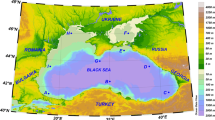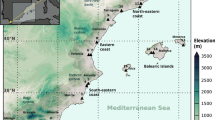Abstract
The main objective of the present study is to perform a trend analysis and investigate the possible changes in the frequency and wind intensity of the Etesians during June to September of the years 1979 to 2009. The analysis is based mainly on the use of Reanalysis-1 data from the National Centers for Environmental Prediction/National Center for Atmospheric Research. The results are indicative of negative trends in the frequency and wind speed (WS) of the Etesians. During the 31-year period studied, the total number of Etesian days from June to September decreased by about 4.6 days, while the monthly maximum intensity of the daily WS was reduced by almost 1 m s−1. The above indications are strengthened by similar results derived from the trend analysis of observational wind data in the central Aegean for the years 1955 to 2002. The negative trend in the frequency of the Etesian days could be explained by a decreasing trend in the pressure gradient between the central and southern Europe high-pressure center and the Middle East low-pressure center, which cause the Etesians system. In the study, a possible association between the Southern Oscillation and the Etesian winds is also revealed. The negative trend in the frequency and WS of the Etesian winds could imply a reduced cooling mechanism in the eastern Mediterranean in the summer period due to climate change.












Similar content being viewed by others
References
Brody LR, Nestor MJR (1985) Regional forecasts for the Mediterranean basin. Technical report, no. 80–110. Naval Environmental Prediction Research Facility, Monterey
Burlando M (2009) The synoptic-scale surface wind climate regimes of the Mediterranean Sea according to the cluster analysis of ERA-40 wind fields. Theor Appl Climatol 96:69–83. doi:10.1007/s00704-008-0033-5
Chattopadhyay J, Bhatla R (1993) Influence of Southern Oscillation index on the variability and predictability of Indian Monsoon. A Reappraisal. Pure Appl Geophys 141:177–188. doi:10.1007/BF00876242
Fedorov AV, Philander SG (2000) Is El Niño changing? Science 288:1997–2002. doi:10.1126/science.288.5473.1997
Giakoumi A, Maggos T, Michopoulos J, Helmis C, Vasilakos C (2009) PM2.5 and volatile organic compounds (VOCs) in ambient air: a focus on the effect of meteorology. Environ Monit Assess 152:83–95. doi:10.1007/s10661-008-0298-2
IPCC (2007) Climate change 2007: the physical science basis. In: Solomon S, Qin D, Manning M, Chen Z, Marquis M, Averyt KB, Tignor M, Miller HL (eds) Contribution of Working Group I to the Fourth Assessment Report of the Intergovernmental Panel on Climate Change. Cambridge University Press, Cambridge
Kallos G, Kotroni V, Lagouvardos K, Papadopoulos A (1998) On the long range transport of air pollutants from Europe to Africa. Geophys Res Lett 25:619–622. doi:10.1029/97GL03317
Kalnay E, Kanamitsu M, Kistler R, Collins W, Deaven D, Gandin L, Iredell M, Saha S, White G, Woolen J, Zhu Y, Chelliah M, Ebisuzaki W, Higgins W, Janowiak J, Mo KC, Ropelewski C, Wang J, Leetmaa A, Reynolds R, Jenne R, Joseph D (1996) The NCEP/NCAR reanalysis 40-year project. B Am Meteorol Soc 77:437–471
Karapiperis L (1951) On the periodicity of Etesian in Athens. Weather 6:378–379
Kioutsioukis I, Melas D, Zerefos C (2010) Statistical assessment of changes in climate extremes over Greece (1955–2002). Int J Climatol 30:1723–1737. doi:10.1002/joc.2030
Kistler R, Kalnay E, Collins W, Saha S, White G, Woollen J, Chelliah M, Ebisuzaki W, Kanamitsu M, Kousky V, van den Dool H, Jenne R, Fiorino M (2001) The NCEP–NCAR 50-year reanalysis: monthly means CD-ROM and documentation. B Am Meteorol Soc 82:247–268
Koletsis I, Lagouvardos K, Kotroni V, Bartzokas A (2009) The interaction of northern wind flow with the complex topography of Crete Island—part 1: observational study. Nat Hazard Earth Sys 9:1845–1855
Kotroni V, Lagouvardos K, Lalas D (2001) The effect of the island of Crete on the Etesian winds over the Aegean Sea. Q J R Meteorol Soc 127:1917–1937. doi:10.1002/qj.49712757604
Maheras P (1980) The problem of Etesians [Le probleme des Etesiens]. Mediterranée 40:57–66
Makrogiannis TJ, Dikaiakos JC (1990) Large scale patterns of atmospheric circulation anomalies associated to long spells of etesian wind-days over Greece. In: Brazdil R (ed) Climatic change in the historical and the instrumental periods. Mararyk University, Brno, pp 307–309
Melas D, Ziomas I, Klemm O, Zerefos CS (1998) Flow dynamics in Athens area under moderate large-scale winds. Atmos Environ 32:2209–2222. doi:10.1016/S1352-2310(97)00436-6
Metaxas DA (1977) The interannual variability of the etesian frequency as a response of atmospheric circulation anomalies. Bulletin of the Hellenic Meteorological Society 2:30–40
Metaxas DA, Bartzokas A (1994) Pressure covariability over the Atlantic, Europe and N. Africa. Application: Centers of Action for Temperature, Winter Precipitation and Summer Winds in Athens, Greece. Theor Appl Climatol 49:9–18. doi:10.1007/BF00866284
Meteorological Office (1962) Weather in Mediterranean. General meteorology, Vol. I, 2nd edn. H.M.S.O, London
Nastos PT, Philandras CM, Metaxas D (1997) Relationship between number of Etesians days and mean air temperature. In: Proceedings of the Hellenic Conference “Archipelagos Technologies”, 22–24 October 1997, Piraeus, Greece, pp 236–242
Pezzoli A (2005) Observation and analysis of etesian wind storms in the Saroniko Gulf. Ad Geo 2:187–194. doi:10.5194/adgeo-2-187-2005
Repapis C, Zerefos C, Tritakis B (1978) On the Etesians over the Aegean. Proceedings of the Academy of Athens 52:572–606
Repapis CC, Zerefos CS (1990) Evidence for the southern oscillation in the variation of the etesian winds. In: Asimakopoulos D, Theoharatos G (eds) In Memoriam L. Carapiperis. University of Athens, Athens, pp 348–355
Retalis D, Retalis A (1998) Effects of air pollution and wind on the large-ion concentration in the air above Athens. J Geophys Res 103:13927–13932. doi:10.1029/97JD02224
Sen PK (1968) Estimates of the regression coefficient based on Kendall’s Tau. J Am Stat Assoc 63:1379–1389
Tourpali K (1994) The quasi biennial oscillation and the southern oscillation in the atmosphere. Dissertation, Aristotle University of Thessaloniki
Tourpali K, Zerefos C, Repapis C, Makrogiannis T (1994) The influence of the Southern Oscillation on the number of Etesians days in Greece. In: 2nd Panhellenic Conference of Meteorology, Climatology and Atmospheric Physics, 29–30 September 1994, Thessaloniki, Greece
Trenberth KE, Hoar TJ (1996) The 1990–1995 El Niño–Southern Oscillation event: longest on record. Geophys Res Lett 23:57–60. doi:10.1029/95GL03602
Tritakis BP (1982) Etesians distribution within the Bartel rotations no. 1938–2027 (1975–1981). Geophys Res Lett 9:1225–1226. doi:10.1029/GL009i011p01225
Tritakis VP (1984) Possible solar signature on a well-established weather phenomenon. J Geophys Res 89:2609–2615. doi:10.1029/JD089iD02p02609
Tritakis VP (1985) Does the interplanetary magnetic field and the solar activity contribute to the tropospheric circulation? Pure Appl Geophys 123:476–486. doi:10.1007/BF00880746
Vidale PL, Lüthi D, Wegmann R, Schär C (2007) European summer climate variability in a heterogeneous multi-model ensemble. Clim Change 81:209–232. doi:10.1007/s10584-006-9218-z
Webster PJ, Magana O, Palmer TN, Shukla J, Tomas RA, Yanai M, Yasunari T (1998) Monsoons: processes, predictability, and the prospects for prediction. J Geophys Res 103:14451–14510. doi:10.1029/97JC02719
Wolter K, Timlin MS (1993) Monitoring ENSO in COADS with a seasonally adjusted principal component index. In: Proceedings of the 17th Climate Diagnostics Workshop, Norman, OK, NOAA/NMC/CAC, NSSL, Oklahoma Clim. Survey, CIMMS and the School of Meteor., Univ. of Oklahoma, pp 52–57
Wolter K, Timlin MS (1998) Measuring the strength of ENSO events—how does 1997/98 rank? Weather 53:315–324
Zanis P, Kapsomenakis I, Philandras C, Douvis K, Nikolakis D, Kanelopoulou E, Zerefos C, Repapis C (2009) Analysis of an ensemble of present-day and future regional climate simulations for Greece. Int J Climatol 29:1614–1633. doi:10.1002/joc.1809
Zecchetto S, Cappa C (2001) The spatial structure of the Mediterranean Sea winds revealed by ERS-1 scatterometer. Int J Remote Sens 22:45–70. doi:10.1080/014311601750038848
Zerefos CS, Kourtidis KA, Balis D, Bais A, Calpini B (2001) Photochemical activity over the Eastern Mediterranean under variable environmental conditions. Phys Chem Earth 26:549–554. doi:10.1016/S1464-1917(01)00045-9
Zhang Q, Guan Y, Yang H (2008) ENSO amplitude change in observation and coupled models. Adv Atmos Sci 25:331–336. doi:10.1007/s00376-008-0361-5
Ziomas I (1998) The Mediterranean Campaign of Photochemical Tracers-Transport and chemical evolution (MEDCAPHOT-TRACE): an outline. Atmos Environ 32:2045–2053. doi:10.1016/S1352-2310(97)00413-5
Ziv B, Saaroni H, Alpert P (2004) The factors governing the summer regime of the Eastern Mediterranean. Int J Climatol 24:1859–1871. doi:10.1002/joc.1113
Acknowledgments
This work was funded by the European Union’s Seventh Framework Programme (FP7/2007-2013) under Grant Agreement no. 218793 (project title: Monitoring Atmospheric Composition and Climate). We thank Dr. Philandras, researcher of the Research Centre for Atmospheric Physics and Climatology of the Academy of Athens (Greece), for providing us with the dataset for the parameter L of the Etesian winds. We thank Dr. Kioutsioukis for the comments on the trend analysis. NCEP Reanalysis data and images were provided by the NOAA/OAR/ESRL Physical Sciences Division, Boulder, Colorado, USA, from their Web site at http://www.esrl.noaa.gov/psd/.
Author information
Authors and Affiliations
Corresponding author
Rights and permissions
About this article
Cite this article
Poupkou, A., Zanis, P., Nastos, P. et al. Present climate trend analysis of the Etesian winds in the Aegean Sea. Theor Appl Climatol 106, 459–472 (2011). https://doi.org/10.1007/s00704-011-0443-7
Received:
Accepted:
Published:
Issue Date:
DOI: https://doi.org/10.1007/s00704-011-0443-7




